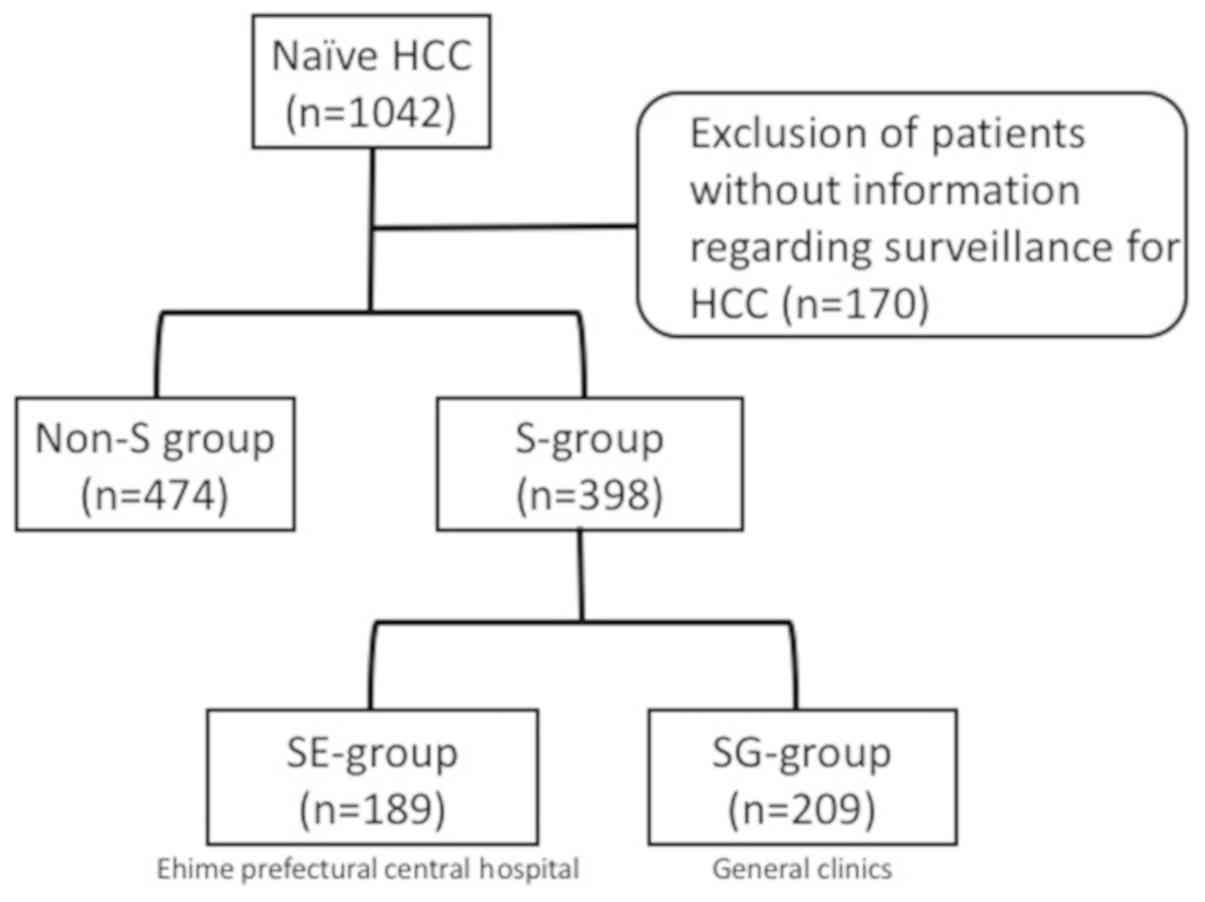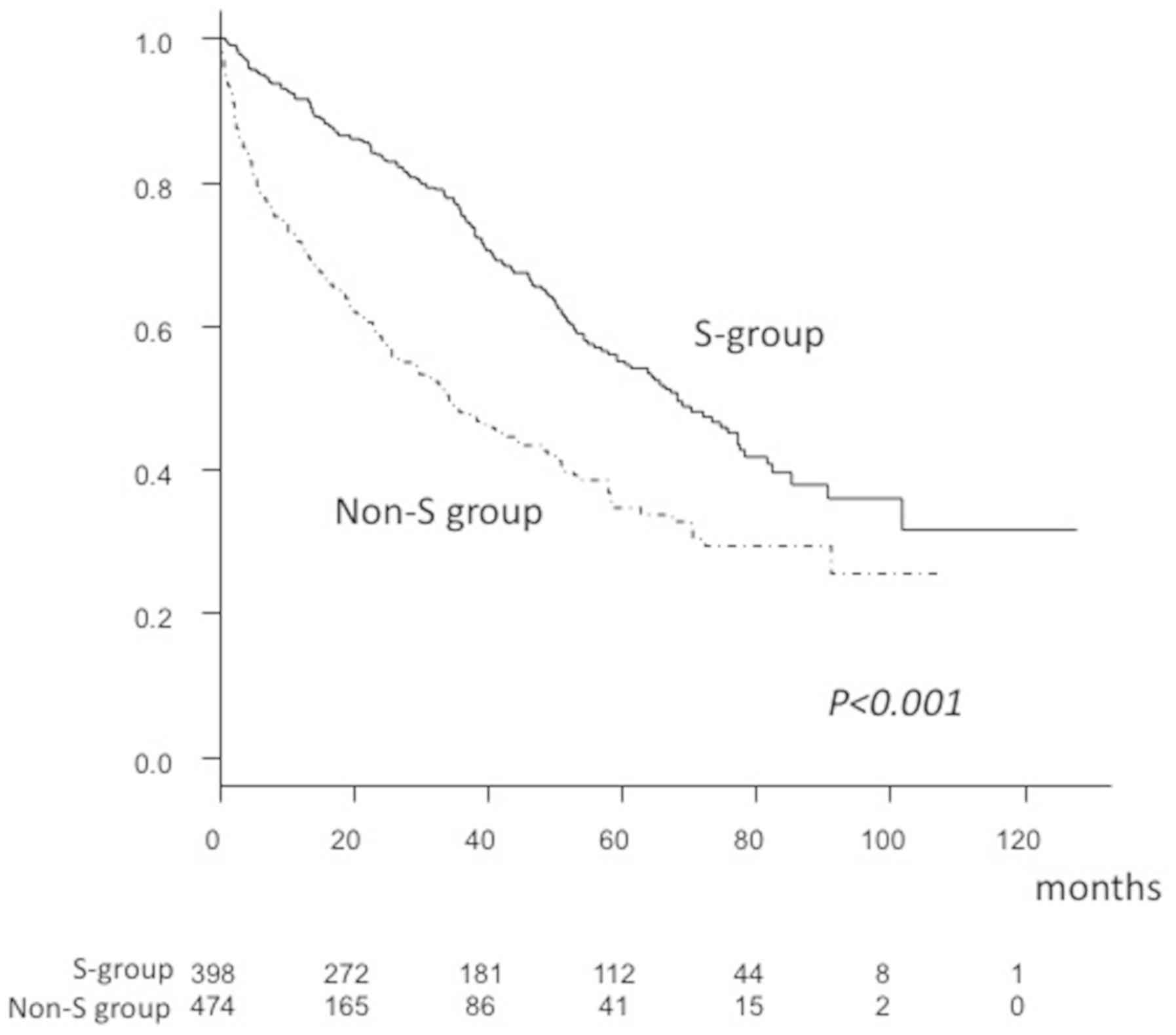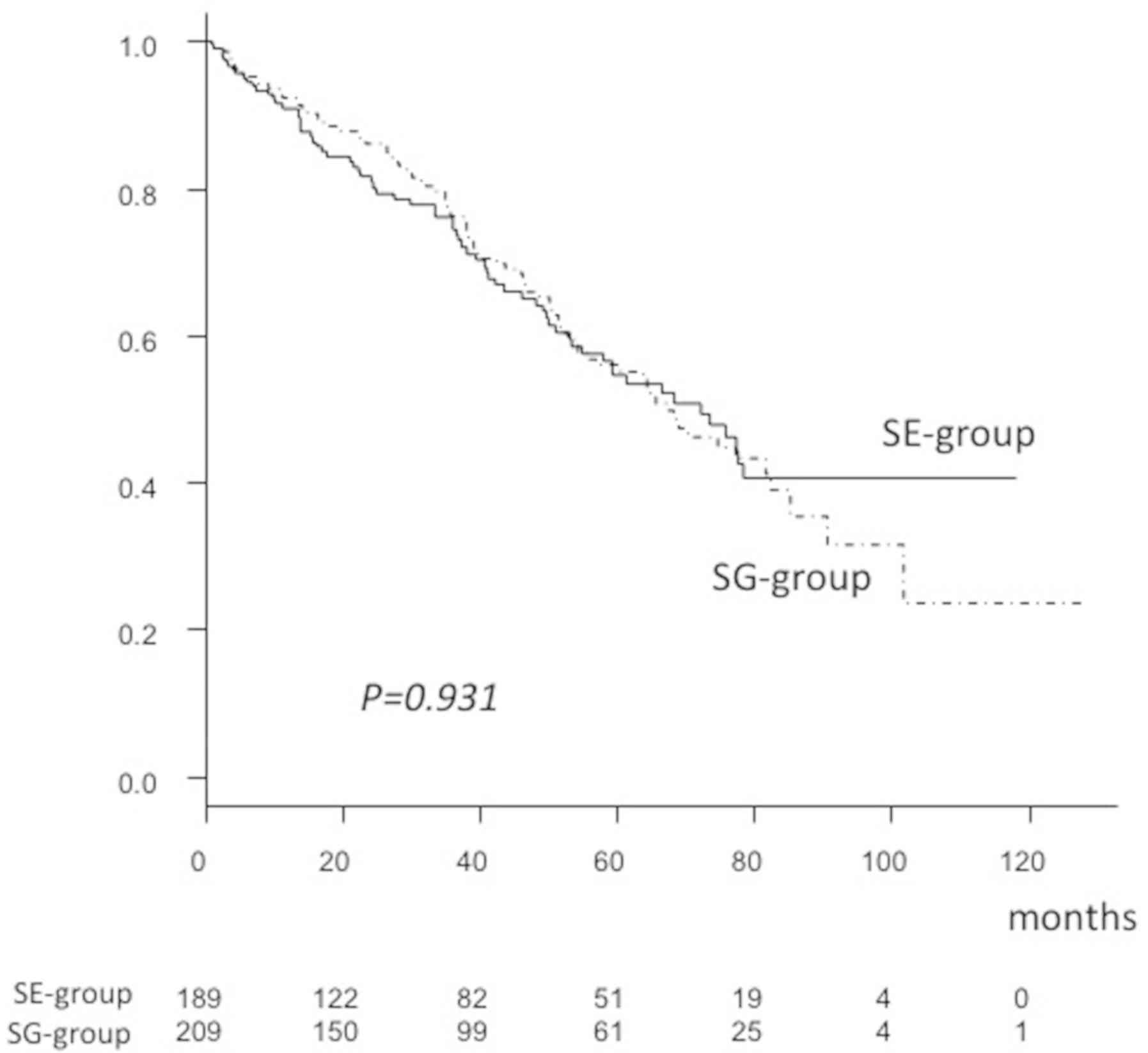|
1
|
Song TJ, Ip EW and Fong Y: Hepatocellular
carcinoma: Current surgical management. Gastroenterology 127 (5
Suppl 1). S248–S260. 2004.
|
|
2
|
Parkin DM, Bray F, Ferlay J and Pisani P:
Global cancer statistics, 2002. CA Cancer J Clin. 55:74–108. 2005.
View Article : Google Scholar : PubMed/NCBI
|
|
3
|
Hiraoka A, Hidaka S, Shimizu Y, Utsunomiya
H, Imai Y, Tatsukawa H, Tazuya N, Yamago H, Yorimitsu N, Tanihira
T, et al: Recent trends of Japanese hepatocellular carcinoma due to
HCV in aging society. Hepatogastroenterology. 59:1893–1895.
2012.PubMed/NCBI
|
|
4
|
Tada T, Kumada T, Toyoda H, Tsuji K,
Hiraoka A and Tanaka J: Impact of FIB-4 index on hepatocellular
carcinoma incidence during nucleos(t)ide analogue therapy in
patients with chronic hepatitis B: An analysis using time-dependent
receiver operating characteristic. J Gastroenterol Hepatol.
32:451–458. 2017. View Article : Google Scholar : PubMed/NCBI
|
|
5
|
Kudo M, Chung H, Haji S, Osaki Y, Oka H,
Seki T, Kasugai H, Sasaki Y and Matsunaga T: Validation of a new
prognostic staging system for hepatocellular carcinoma: The JIS
score compared with the CLIP score. Hepatology. 40:1396–1405. 2004.
View Article : Google Scholar : PubMed/NCBI
|
|
6
|
Hiraoka A, Kumada T, Michitaka K, Toyoda
H, Tada T, Ueki H, Kaneto M, Aibiki T, Okudaira T, Kawakami T, et
al: Usefulness of albumin-bilirubin grade for evaluation of
prognosis of 2584 Japanese patients with hepatocellular carcinoma.
J Gastroenterol Hepatol. 31:1031–1036. 2016. View Article : Google Scholar : PubMed/NCBI
|
|
7
|
Hiraoka A, Kumada T, Kudo M, Hirooka M,
Tsuji K, Itobayashi E, Kariyama K, Ishikawa T, Tajiri K, Ochi H, et
al: Albumin-Bilirubin (ALBI) grade as part of the evidence-based
clinical practice guideline for HCC of the Japan society of
hepatology: A comparison with the liver damage and child-pugh
classifications. Liver Cancer. 6:204–215. 2017. View Article : Google Scholar : PubMed/NCBI
|
|
8
|
Miyagawa S, Makuuchi M, Kawasaki S and
Kakazu T: Criteria for safe hepatic resection. Am J Surg.
169:589–594. 1995. View Article : Google Scholar : PubMed/NCBI
|
|
9
|
Shiina S, Tateishi R, Arano T, Uchino K,
Enooku K, Nakagawa H, Asaoka Y, Sato T, Masuzaki R, Kondo Y, et al:
Radiofrequency ablation for hepatocellular carcinoma: 10-year
outcome and prognostic factors. Am J Gastroenterol. 107:569–577;
quiz 578. 2012. View Article : Google Scholar : PubMed/NCBI
|
|
10
|
Hiraoka A, Michitaka K, Horiike N, Hidaka
S, Uehara T, Ichikawa S, Hasebe A, Miyamoto Y, Ninomiya T, Sogabe
I, et al: Radiofrequency ablation therapy for hepatocellular
carcinoma in elderly patients. J Gastroenterol Hepatol. 25:403–407.
2010. View Article : Google Scholar : PubMed/NCBI
|
|
11
|
Llovet JM, Ricci S, Mazzaferro V, Hilgard
P, Gane E, Blanc JF, de Oliveira AC, Santoro A, Raoul JL, Forner A,
et al: Sorafenib in advanced hepatocellular carcinoma. N Engl J
Med. 359:378–390. 2008. View Article : Google Scholar : PubMed/NCBI
|
|
12
|
Bruix J, Qin S, Merle P, Granito A, Huang
YH, Bodoky G, Pracht M, Yokosuka O, Rosmorduc O, Breder V, et al:
Regorafenib for patients with hepatocellular carcinoma who
progressed on sorafenib treatment (RESORCE): A randomised,
double-blind, placebo-controlled, phase 3 trial. Lancet. 389:56–66.
2017. View Article : Google Scholar : PubMed/NCBI
|
|
13
|
Kudo M, Finn RS, Qin S, Han KH, Ikeda K,
Piscaglia F, Baron A, Park JW, Han G, Jassem J, et al: Lenvatinib
versus sorafenib in first-line treatment of patients with
unresectable hepatocellular carcinoma: A randomised phase 3
non-inferiority trial. Lancet. 391:1163–1173. 2018. View Article : Google Scholar : PubMed/NCBI
|
|
14
|
Hiraoka A, Kumada T, Kariyama K, Takaguchi
K, Itobayashi E, Shimada N, Tajiri K, Tsuji K, Ishikawa T, Ochi H,
et al: Therapeutic potential of lenvatinib for unresectable
hepatocellular carcinoma in clinical practice: Multicenter
analysis. Hepatol Res. 49:111–117. 2019.PubMed/NCBI
|
|
15
|
Bolondi L, Sofia S, Siringo S, Gaiani S,
Casali A, Zironi G, Piscaglia F, Gramantieri L, Zanetti M and
Sherman M: Surveillance programme of cirrhotic patients for early
diagnosis and treatment of hepatocellular carcinoma: A cost
effectiveness analysis. Gut. 48:251–259. 2001. View Article : Google Scholar : PubMed/NCBI
|
|
16
|
Tanaka H, Nouso K, Kobashi H, Kobayashi Y,
Nakamura S, Miyake Y, Ohnishi H, Miyoshi K, Iwado S, Iwasaki Y, et
al: Surveillance of hepatocellular carcinoma in patients with
hepatitis C virus infection may improve patient survival. Liver
Int. 26:543–551. 2006. View Article : Google Scholar : PubMed/NCBI
|
|
17
|
Makuuchi M, Kokudo N, Arii S, Futagawa S,
Kaneko S, Kawasaki S, Matsuyama Y, Okazaki M, Okita K, Omata M, et
al: Development of evidence-based clinical guidelines for the
diagnosis and treatment of hepatocellular carcinoma in Japan.
Hepatol Res. 38:37–51. 2008. View Article : Google Scholar : PubMed/NCBI
|
|
18
|
Kokudo N, Hasegawa K, Akahane M, Igaki H,
Izumi N, Ichida T, Uemoto S, Kaneko S, Kawasaki S, Ku Y, et al:
Evidence-based clinical practice guidelines for hepatocellular
carcinoma: The Japan society of hepatology 2013 update (3rd JSH-HCC
Guidelines). Hepatol Res. 45:2015. View Article : Google Scholar
|
|
19
|
Sano K, Ichikawa T, Motosugi U, Sou H,
Muhi AM, Matsuda M, Nakano M, Sakamoto M, Nakazawa T, Asakawa M, et
al: Imaging study of early hepatocellular carcinoma: Usefulness of
gadoxetic acid-enhanced MR imaging. Radiology. 261:834–844. 2011.
View Article : Google Scholar : PubMed/NCBI
|
|
20
|
Bruix J and Sherman M; Practice Guidelines
Committee, American Association for the Study of Liver Diseases, :
Management of hepatocellular carcinoma. Hepatology. 42:1208–1236.
2005. View Article : Google Scholar : PubMed/NCBI
|
|
21
|
Hiraoka A, Hiasa Y, Onji M and Michitaka
K: New contrast enhanced ultrasonography agent: Impact of Sonazoid
on radiofrequency ablation. J Gastroenterol Hepatol. 26:616–618.
2011. View Article : Google Scholar : PubMed/NCBI
|
|
22
|
Hiraoka A, Ichiryu M, Tazuya N, Ochi H,
Tanabe A, Nakahara H, Hidaka S, Uehara T, Ichikawa S, Hasebe A, et
al: Clinical translation in the treatment of hepatocellular
carcinoma following the introduction of contrast-enhanced
ultrasonography with Sonazoid. Oncol Lett. 1:57–61. 2010.
View Article : Google Scholar : PubMed/NCBI
|
|
23
|
The Liver Cancer Study Group of Japan. The
general rules for the clinical and pathological study of primary
liver cancer. 6th. Kanehara; Tokyo: 26. 2015
|
|
24
|
Kanda Y: Investigation of the freely
available easy-to-use software ‘EZR’ for medical statistics. Bone
Marrow Transplant. 48:452–458. 2013. View Article : Google Scholar : PubMed/NCBI
|
|
25
|
Kan M, Hiraoka A, Uehara T, Hidaka S,
Ichiryu M, Nakahara H, Ochi H, Tanabe A, Kodama A, Hasebe A, et al:
Evaluation of contrast-enhanced ultrasonography using
perfluorobutane [Sonazoid(®)] in patients with small
hepatocellular carcinoma: Comparison with dynamic computed
tomography. Oncol Lett. 1:485–488. 2010. View Article : Google Scholar : PubMed/NCBI
|
|
26
|
Hiraoka A, Horiike N, Yamashita Y, Koizumi
Y, Doi K, Yamamoto Y, Hasebe A, Ichikawa S, Yano M, Miyamoto Y, et
al: Efficacy of radiofrequency ablation therapy compared to
surgical resection in 164 patients in Japan with single
hepatocellular carcinoma smaller than 3 cm, along with report of
complications. Hepatogastroenterology. 55:2171–2174.
2008.PubMed/NCBI
|
|
27
|
Hirooka M, Iuchi H, Kumagi T, Shigematsu
S, Hiraoka A, Uehara T, Kurose K, Horiike N and Onji M: Virtual
sonographic radiofrequency ablation of hepatocellular carcinoma
visualized on CT but not on conventional sonography. AJR Am J
Roentgenol. 186 (5 Suppl):S255–S260. 2006. View Article : Google Scholar : PubMed/NCBI
|
|
28
|
Uehara T, Hirooka M, Ishida K, Hiraoka A,
Kumagi T, Kisaka Y, Hiasa Y and Onji M: Percutaneous
ultrasound-guided radiofrequency ablation of hepatocellular
carcinoma with artificially induced pleural effusion and ascites. J
Gastroenterol. 42:306–311. 2007. View Article : Google Scholar : PubMed/NCBI
|
|
29
|
Singal AG, Conjeevaram HS, Volk ML, Fu S,
Fontana RJ, Askari F, Su GL, Lok AS and Marrero JA: Effectiveness
of hepatocellular carcinoma surveillance in patients with
cirrhosis. Cancer Epidemiol Biomarkers Prev. 21:793–799. 2012.
View Article : Google Scholar : PubMed/NCBI
|
|
30
|
Zhang BH, Yang BH and Tang ZY: Randomized
controlled trial of screening for hepatocellular carcinoma. J
Cancer Res Clin Oncol. 130:417–422. 2004. View Article : Google Scholar : PubMed/NCBI
|
|
31
|
Chen JG, Parkin DM, Chen QG, Lu JH, Shen
QJ, Zhang BC and Zhu YR: Screening for liver cancer: Results of a
randomised controlled trial in Qidong, China. J Med Screen.
10:204–209. 2003. View Article : Google Scholar : PubMed/NCBI
|
|
32
|
Costentin CE, Layese R, Bourcier V, Cagnot
C, Marcellin P, Guyader D, Pol S, Larrey D, De Lédinghen V, Ouzan
D, et al: Compliance with hepatocellular carcinoma surveillance
guidelines associated with increased lead-time adjusted survival of
patients with compensated viral cirrhosis: A multi-center cohort
study. Gastroenterology. 155:431–442.e10. 2018. View Article : Google Scholar : PubMed/NCBI
|
|
33
|
Toyoda H, Kumada T, Tada T, Mizuno K,
Hiraoka A, Tsuji K, Ishikawa T, Akita T and Tanaka J: Impact of
hepatocellular carcinoma aetiology and liver function on the
benefit of surveillance: A novel approach for the adjustment of
lead-time bias. Liver Int. 38:2260–2268. 2018. View Article : Google Scholar : PubMed/NCBI
|
|
34
|
Tateishi R, Okanoue T, Fujiwara N, Okita
K, Kiyosawa K, Omata M, Kumada H, Hayashi N and Koike K: Clinical
characteristics, treatment, and prognosis of non-B, non-C
hepatocellular carcinoma: A large retrospective multicenter cohort
study. J Gastroenterol. 50:350–360. 2015. View Article : Google Scholar : PubMed/NCBI
|
|
35
|
Urata Y, Yamasaki T, Saeki I, Iwai S,
Kitahara M, Sawai Y, Tanaka K, Aoki T, Iwadou S, Fujita N, et al:
Clinical characteristics and prognosis of non-B non-C
hepatocellular carcinoma patients with modest alcohol consumption.
Hepatol Res. 46:434–442. 2016. View Article : Google Scholar : PubMed/NCBI
|
|
36
|
Hiraoka A, Ochi M, Matsuda R, Aibiki T,
Okudaira T, Kawamura T, Yamago H, Nakahara H, Suga Y, Azemoto N, et
al: Ultrasonography screening for hepatocellular carcinoma in
Japanese patients with diabetes mellitus. J Diabetes. 8:640–646.
2016. View Article : Google Scholar : PubMed/NCBI
|
|
37
|
Kolly P and Dufour JF: Surveillance for
hepatocellular carcinoma in patients with NASH. Diagnostics
(Basel). 6(pii): E222016. View Article : Google Scholar : PubMed/NCBI
|
|
38
|
Sterling RK, Lissen E, Clumeck N, Sola R,
Correa MC, Montaner J, S Sulkowski M, Torriani FJ, Dieterich DT,
Thomas DL, et al: Development of a simple noninvasive index to
predict significant fibrosis in patients with HIV/HCV coinfection.
Hepatology. 43:1317–1325. 2006. View Article : Google Scholar : PubMed/NCBI
|
|
39
|
Vallet-Pichard A, Mallet V, Nalpas B,
Verkarre V, Nalpas A, Dhalluin-Venier V, Fontaine H and Pol S:
FIB-4: An inexpensive and accurate marker of fibrosis in HCV
infection. Comparison with liver biopsy and fibrotest. Hepatology.
46:32–36. 2007. View Article : Google Scholar : PubMed/NCBI
|
|
40
|
Smajerova M, Petrasova H, Little J, Ovesna
P, Andrasina T, Valek V, Nemcova E and Miklosova B:
Contrast-enhanced ultrasonography in the evaluation of incidental
focal liver lesions: A cost-effectiveness analysis. World J
Gastroenterol. 22:8605–8614. 2016. View Article : Google Scholar : PubMed/NCBI
|
|
41
|
Ogawa C, Minami Y, Morioka Y, Noda A,
Arasawa S, Izuta M, Kubo A, Matsunaka T, Tamaki N, Shibatouge M and
Kudo M: Virtual sonography for novice sonographers: Usefulness of
SYNAPSE VINCENT® with pre-check imaging of tumor
location. Oncology. 87 (Suppl 1):S50–S54. 2014. View Article : Google Scholar
|












